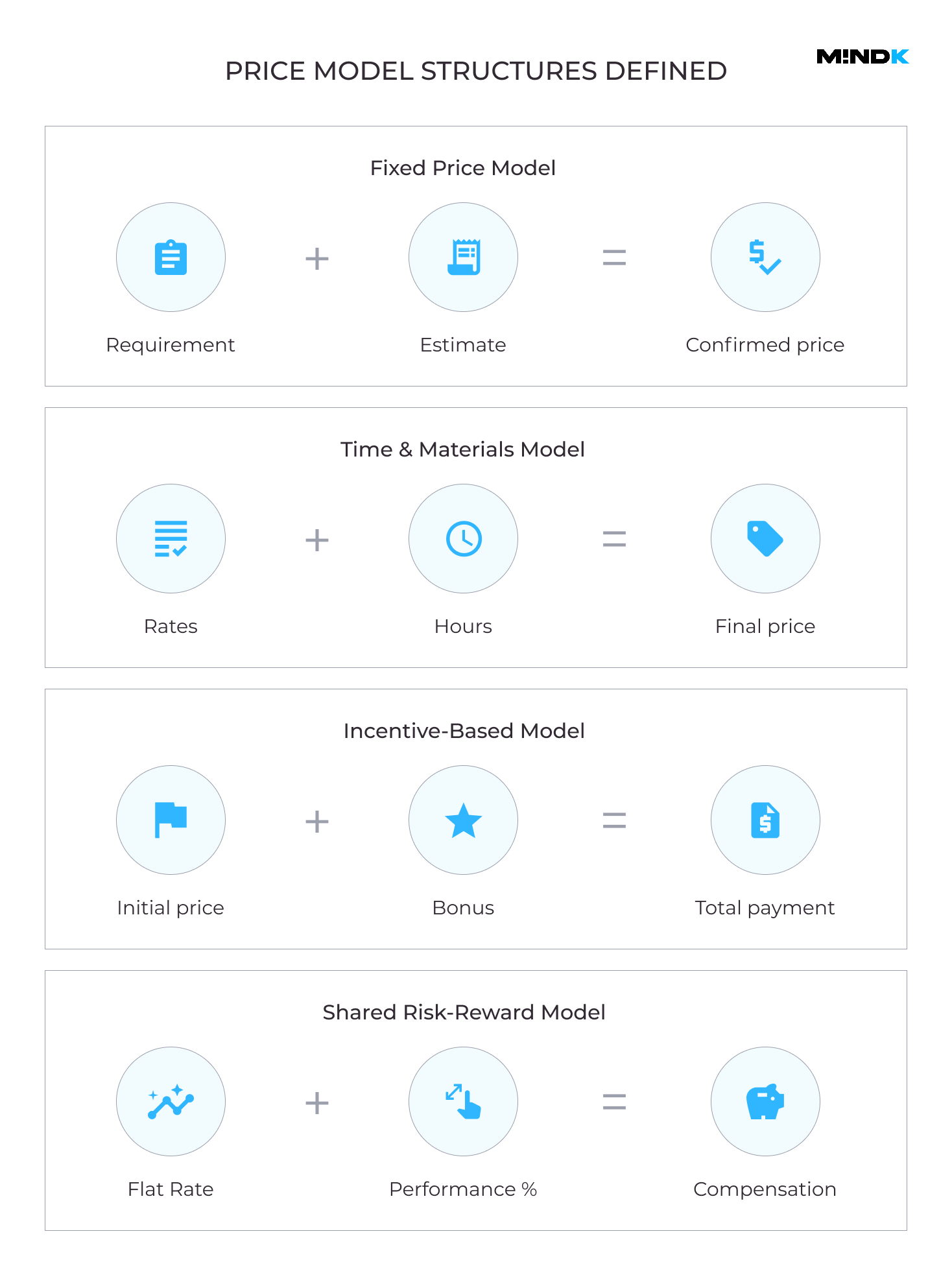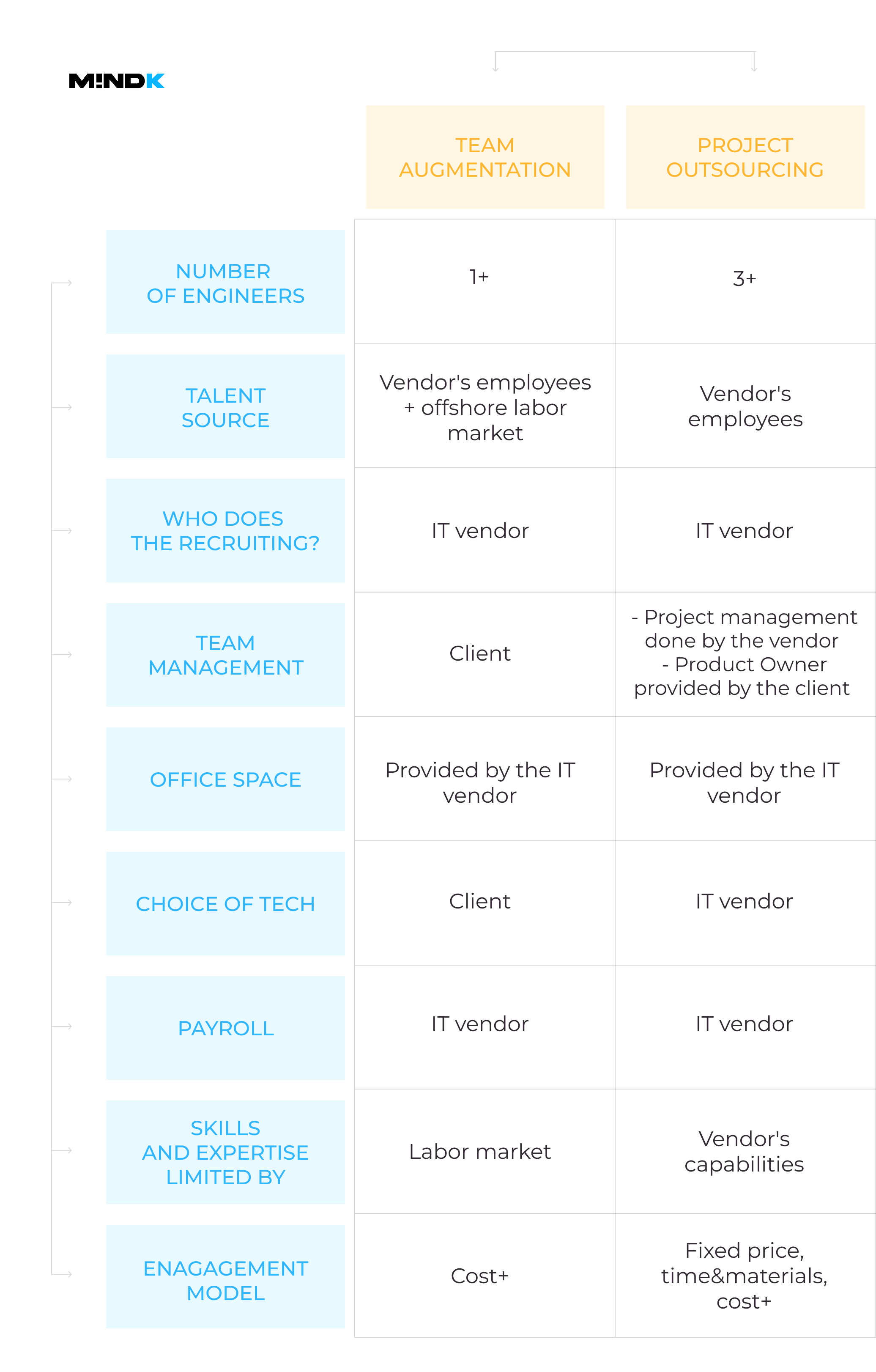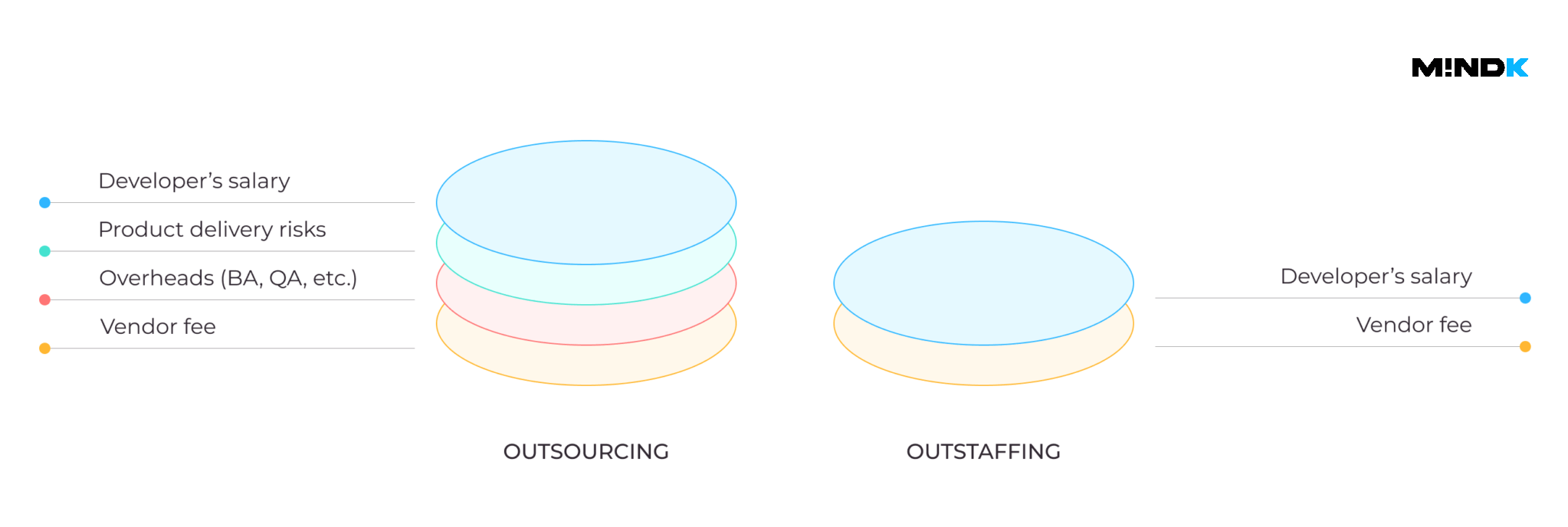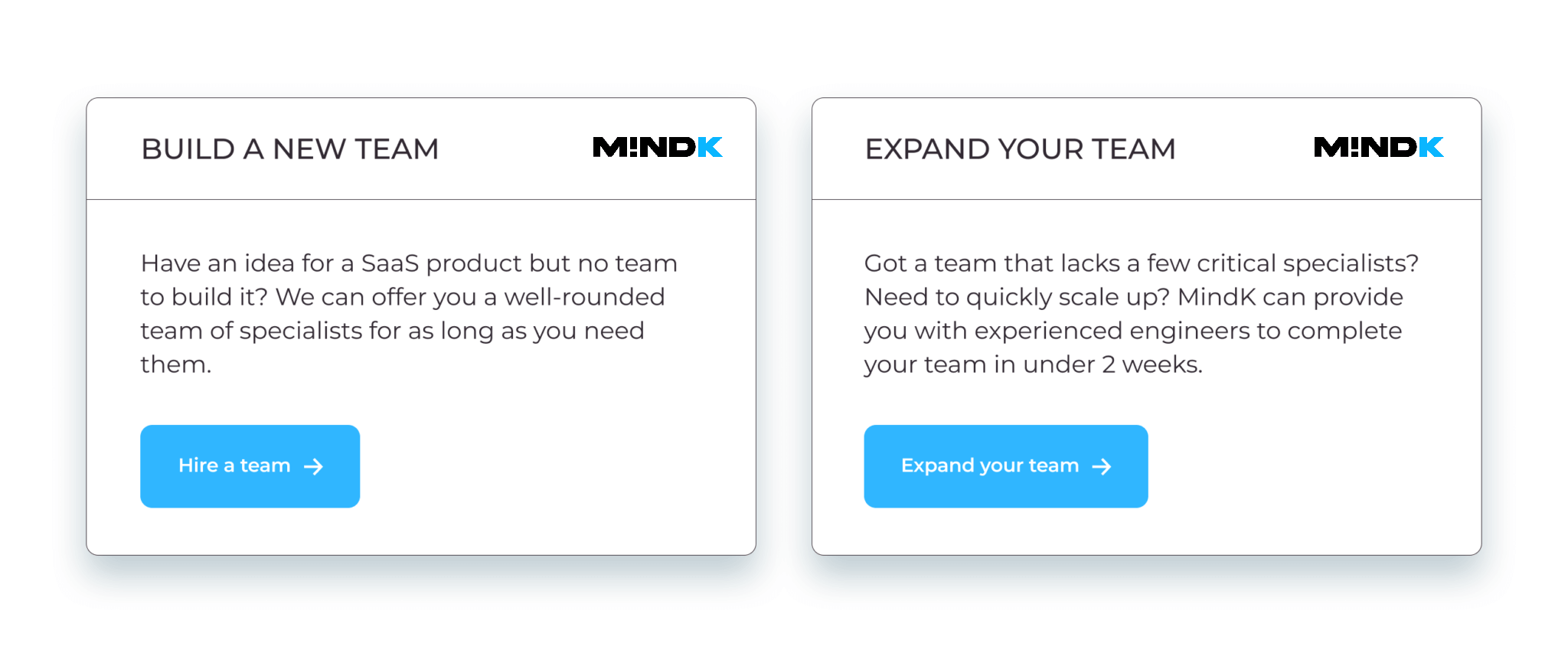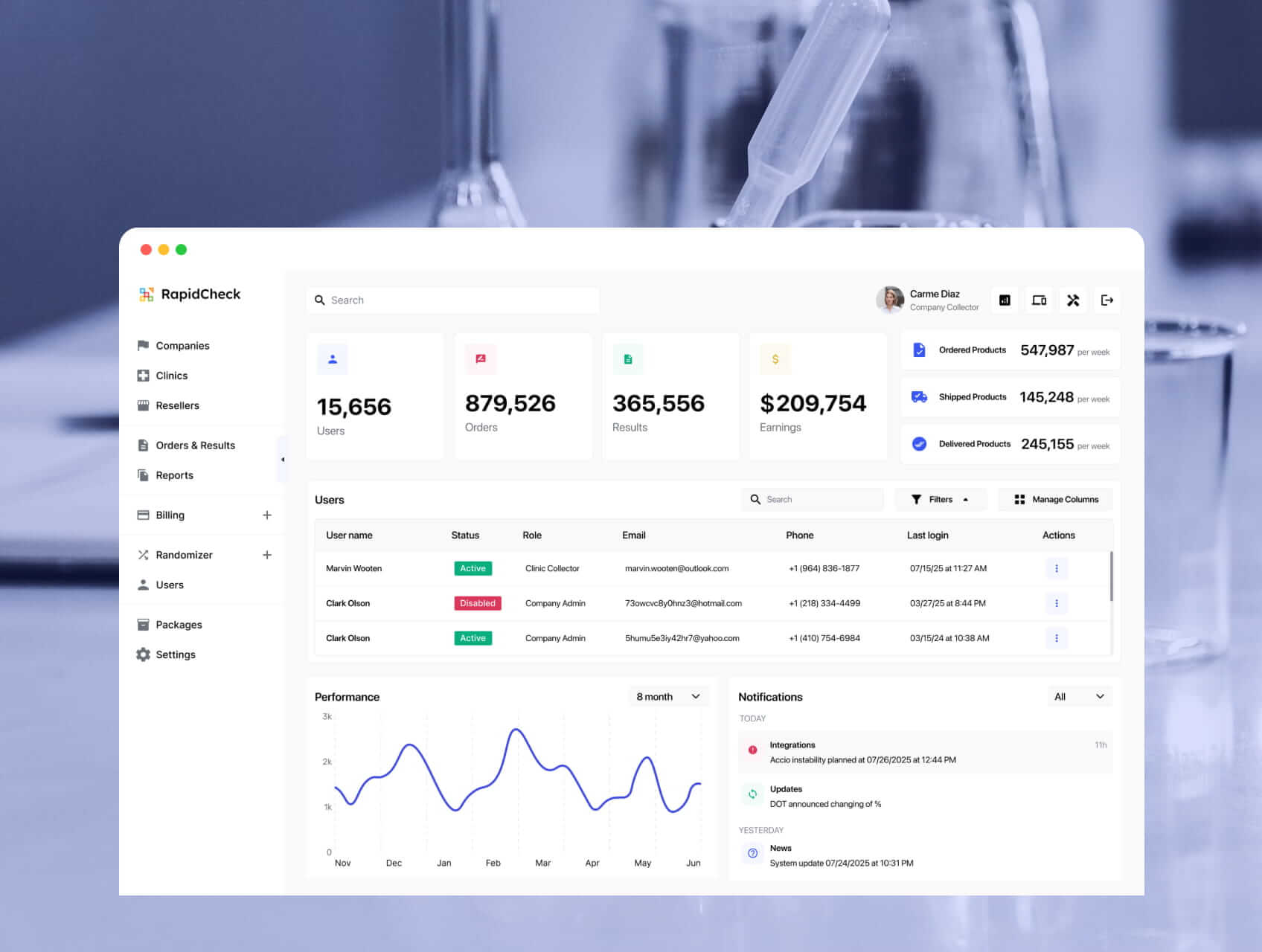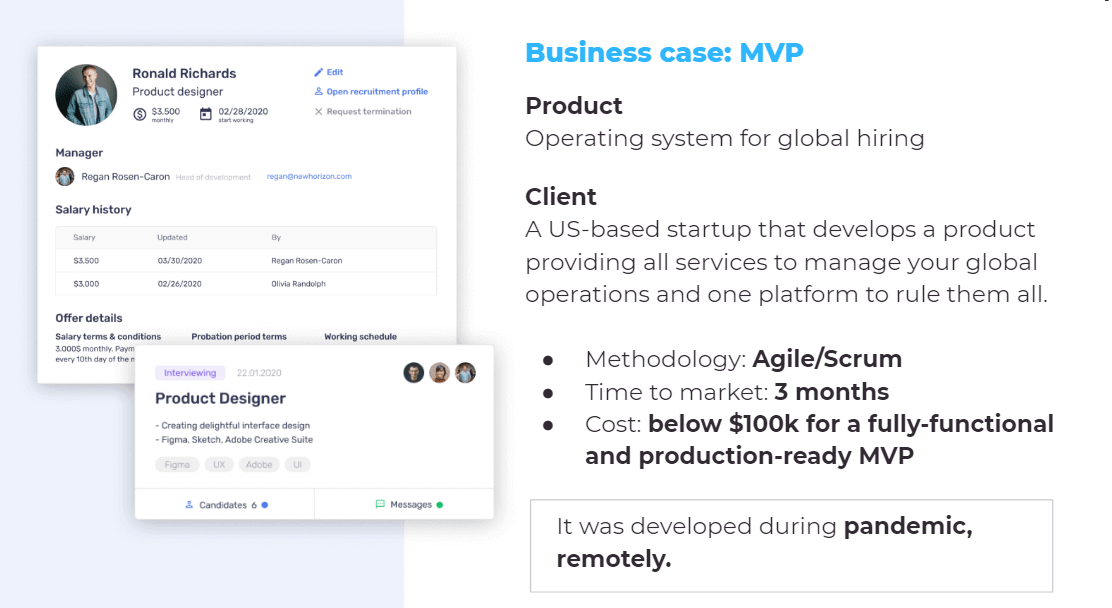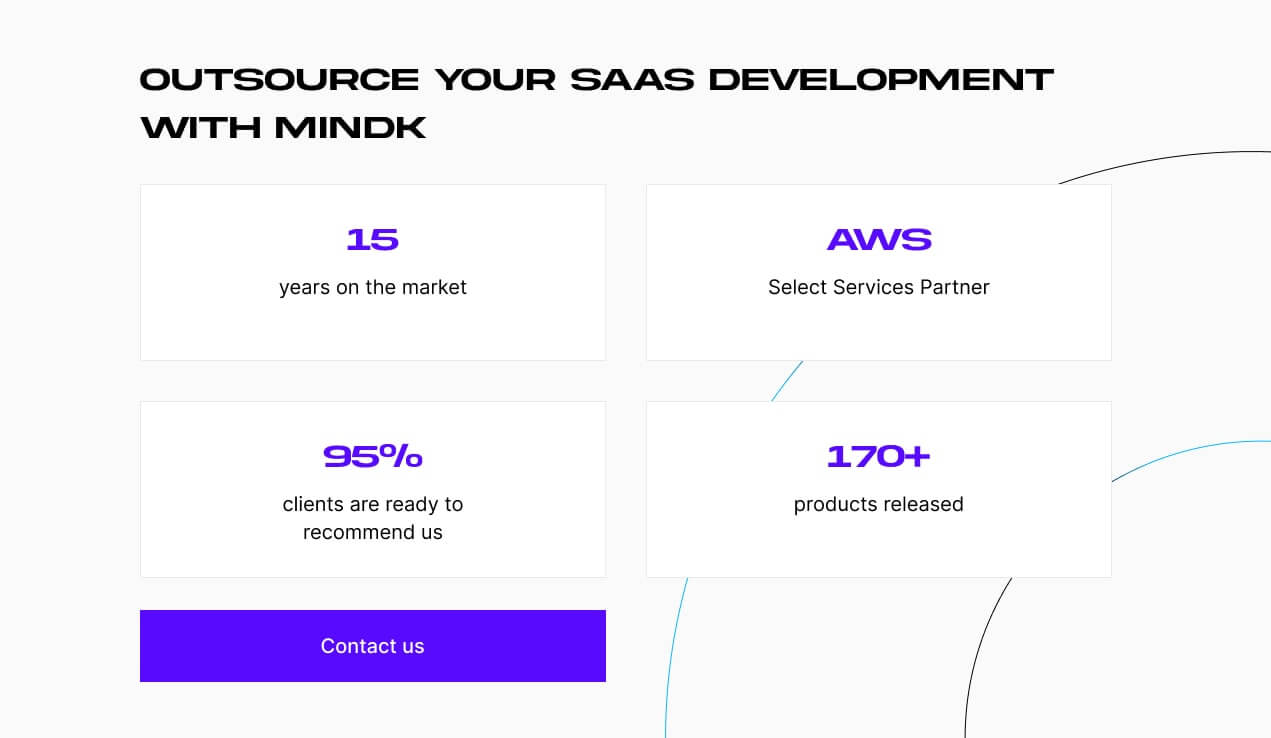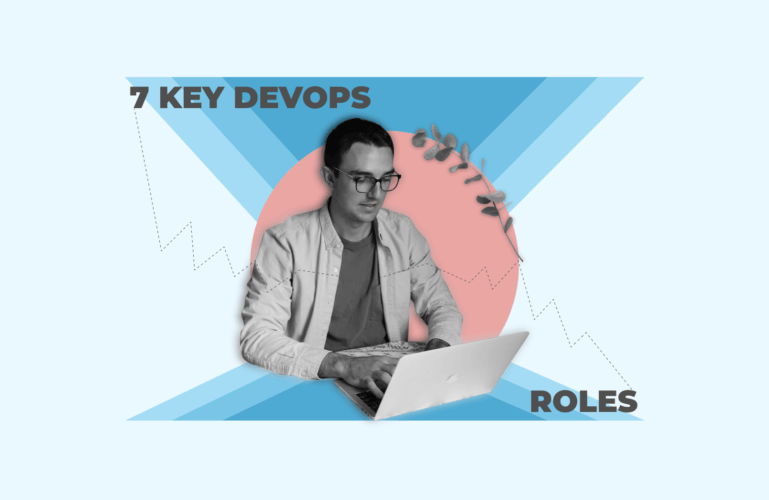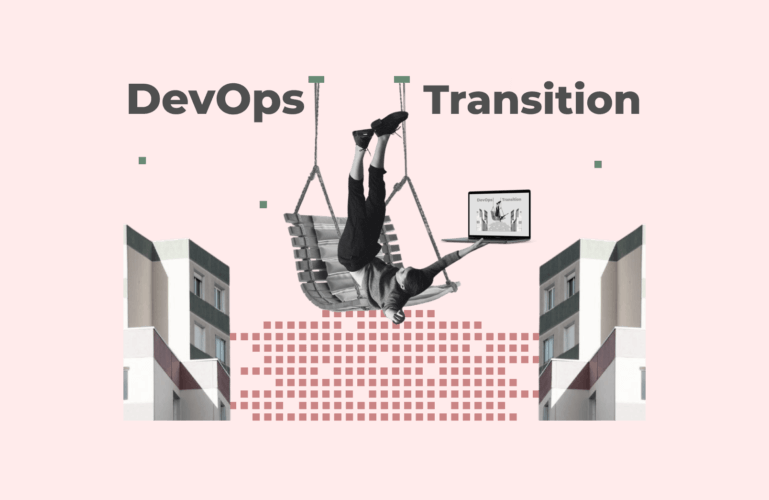Developing a SaaS product in-house seems like the obvious choice. You retain full control and IP and build a team that understands your business inside and out. But is it always the smartest move? Contrary to popular belief, outsourcing SaaS development isn’t about cutting costs.
While lower costs are nice, SaaS outsourcing is about speed, scalability, and resilience in unpredictable markets. Even with a surplus of developers, onboarding, aligning, and optimizing an internal team takes months. Meanwhile, experienced SaaS outsourcing partners can execute immediately and already have the necessary skills in place.
The trick is in vetting potential partners to build a winning product and avoid the risks of outsourcing.
Table of contents:
- What are the reasons (not) to outsource SaaS development?
- What is the best way to outsource SaaS development?
- How to succeed with SaaS outsourcing
- #1 Shortlist potential vendors
- #2 Check vendor reviews
- #3 Learn about the vendor’s approach
- #4 Create a Request for Proposal (RFP)
- #5 Vet their technical skills
- #6 Mitigate risks proactively
- #7 Ask for a Non-Disclosure Agreement (NDA)
- #8 Sign a SaaS outsourcing contract
- #9 Stay involved with your new team
- #10 Define a vendor exit strategy and offboarding plan
What are the reasons to (not) outsource SaaS development?
Fewer and fewer companies view outsourcing primarily as a way to reduce costs (70% in 2020 vs. just 34% in 2025, according to Deloitte). However, SaaS outsourcing remains strong, driven by other factors. So why do companies choose third-party vendors?
Top talent with SaaS and AI expertise
It’s still rare to meet engineers with combined tech skills and SaaS business acumen; people who care about the UX just as much as they care about coding. That’s why companies like MindK are extremely picky when it comes to hiring SaaS developers who know:
- Modern architectural patterns for highly accessible and available applications. This includes microservices, serverless, edge computing, hybrid, and event-driven architectures.
- Cutting-edge front-end frameworks like React and Angular.
- Backend and API development (REST, GraphQL, gRPC, composable SaaS, event-driven microservices, legacy API integration).
- AI and ML integration. Features like predictive analytics, LLM integration, or AI-accelerated development are no longer niche in SaaS development. This includes understanding OpenAI, Google Vertex AI, LangChain, vector databases, and the basics of MLOps.
- Application security and QA best practices likeTDD, zero-trust architecture, automated security testing, knowledge of privacy & compliance regulations.
- Cloud computing and cost optimization (FinOps, Kubernetes, Terraform basics). AWS alone offers over 300 services for SaaS apps. Making the wrong choice can mean the difference between paying $20K and $6K a month for cloud costs.
One of the most important qualities that SaaS software development companies look for is what I call a product mindset. In fast-paced Agile and Lean environments, developers need to embrace a wide range of duties. They help teammates test the application, tweak its UX, and explain things to stakeholders.
SaaS developers must have excellent soft skills. At MindK, the entire team should be able to talk with the client and manage their own workload. Great SaaS developers are proactive and responsible workers, great communicators, and technical advisors to business stakeholders.
Flexible, scalable teams
The SaaS market is shifting rapidly. Startups often have to pivot, expand, or contract teams based on new conditions.
Once hired, in-house teams become fixed overhead. SaaS outsourcing allows modular team adjustments without layoffs or restructuring pains. You can scale resources up or down on short notice. This includes both in-demand tech specialists, such as Data Scientists, ML & DevOps Engineers, as well as UX/UI Designers, Product Managers, and other non-technical team members.
Faster innovation
Time-to-market is a key metric for any SaaS company. Although there are now tons of engineers available in the USA, it still takes months to hire, onboard, and form a high-performing SaaS team.
Outsourced teams can start development within weeks, bypassing these ramp-up delays. They often consist of engineers who have worked together on multiple SaaS projects, reaching an earlier peak in performance.
Companies like MindK also offer pre-built modules and AI solutions, customizable design elements, and ready-made components to speed up development by 30% and more.
Built-in risk mitigation and resilience
Loss of control, low quality, and vendor lock-in are some of the top outsourcing risks that are well-known among industry decision-makers.
However, outsourcing can also be a risk mitigation strategy, if approached correctly. In-house teams often suffer from key-person risk. If a senior engineer or architect leaves, critical knowledge is lost. SaaS outsourcing companies provide team redundancy so that the know-how is preserved when individuals transition.
Reputable vendors use business continuity plans (BCP), redundant infrastructure, and 24/7 DevOps teams to handle outages or security incidents without downtime. They also have hands-on expertise with key regulations and standards, such as GDPR, HIPAA, FHIR, HL7, DICOM, and CDA, for the industries they specialize in, reducing the risk of legal complications.
Cost-savings
You can outsource SaaS product development that costs $100+ an hour in the US to other countries for $40+ per hour, maintaining the same quality standard. This also frees you from the cost of recruiting, education, and management, additional cash compensation, insurance, paid leave, and overheads.
Startups with tighter budgets can find even cheaper vendors. However, the lower the rates, the faster quality drops. Experience shows that the sweet spot for the cost/quality ratio ranges between $40 and $90 per hour, depending on the location.
Developer rates aren’t the only factor that determines the web development costs. Vendor size, project complexity, choice of technology, and functional and non-functional requirements are also important.
Clients often overlook infrastructure and cloud costs. MindK once consulted a SaaS company with $210M in funding. Each month, they overpaid $14,000 for AWS services, managed databases, and testing environments.
Total Cost of Development (TCD) may also include hidden costs. Change requests, for example, are costly if you choose a fixed-price contract. Some vendors may also require 6–12 month minimum retainers, increasing costs.
This means that the total cost depends on the vendor’s engagement (pricing) models:
- Fixed-price contracts are predictable but require a thorough discovery phase. The vendor also takes on all the risks and management duties. This results in extra contingency costs (10-30%).
- Time & Materials (T&M) requires you to pay a fixed hourly rate plus a fixed vendor fee. T&M is more flexible but requires active cost monitoring to avoid overruns.
- Incentive-based contracts require the vendor to estimate your project based on the initial requirements. You can then add specific rewards for exceeding those original performance objectives.
- Shared risk-reward contracts are a variant of the incentive-based model where partners fund the project together and share rewards for a set period.
- Dedicated Team is cost-effective for long-term projects, but requires ongoing commitment.
At MindK, we only recommend fixed-price contracts for specific, highly regulated industries. You can also use it to build trust with a new partner with a small proof of concept/MVP. After that, switch to a non-fixed-price model. They all offer the flexibility needed for large projects in dynamic markets.
| Cost factor | Typical additional costs |
| Cloud infrastructure | $500-$5K/month |
| Maintenance & bug fixes | 10-20% of initial development cost/year |
| Project management | 15-25% of total project cost |
| Legal and compliance expenses | $10K-$50K |
| Onboarding when switching vendors | $5K-$20K |
What is the best way to outsource SaaS development?
There are many types of outsourcing and even more names vendors use to describe these engagements. However, as a SaaS founder, you need to know about two basic types:
- Staff augmentation (outstaffing, dedicated team).
- Project-based outsourcing (also known as managed services).
IT staff augmentation
This traditional model focuses on filling specific team roles with outsourced specialists. They adopt your company’s culture, tools, and engineering approaches. You provide the daily tasks and manage the engineers while they work as a remote extension of the team.
Pricing in staff augmentation is incredibly transparent—you pay the developer’s hourly rate plus a small vendor’s fee.
Some firms act as recruiters that identify suitable specialists in the global market. Other SaaS outsourcing companies offer pre-vetted specialists who have worked together for many years.
Benefits:
- Retain 100% control over the project. Hand-pick all the candidates, have as many interview rounds as needed, and oversee daily activities.
- Quick scale-up. Start working with an extended team in less than 2 weeks. Swap specialists, expand the team, or cancel services on short notice.
- Save money. The payment model includes no additional fees.
Drawbacks:
- Requires tech expertise to interview candidates, check test assignments, and manage their tasks.
- More responsibilities for the client. You’ll have to onboard and manage developers, budgets, scope, and project timelines.
- Requires well-established development processes to succeed with SaaS product development.
Perfect-fit when you:
- Need to rapidly scale up your team while building your SaaS product.
- Want to save money as a series A/B startup.
- Have a project with an unusual tech stack.
- Want to avoid putting all your eggs in one basket. Diversify risks by working with multiple SaaS outsourcing companies.
Outcome-based outsourcing
This model focused on delivering a successful SaaS product as a cross-functional team.
According to Deloitte, 67% of companies in 2024 prioritized outcome-based services vs. 29% for staff augmentation. They also reported 17% higher satisfaction and planned to increase investment in SaaS outsourcing services.
In outcome-based models, the vendor takes on more responsibilities, including Product Management, Business/System Analysis, UX/UI design, DevOps, QA, and outsourced SaaS development.
On Agile projects, the client typically acts as a Product Owner. The outsourced team helps them analyze user needs, monitor competitors, single out key MVP priorities to prevent scope creep, collect feedback, and build new features to reach long-term objectives.
Benefits:
- Less stress, more results. SaaS development company projects provide all the necessary specialists to complete your project. There’s no necessity to micromanage the team, you are free to focus on your core business.
- No tech skills are needed from the client side. The vendor provides technical Project Management and other necessary skills.
- Clear goals, outcomes, and success conditions defined in the contract. It also specifies the duties and responsibilities of all parties, along with deadlines, budget, and scope.
Drawbacks:
- Less flexible. Drastic changes to the project and team composition typically require an advanced warning and might result in additional fees.
- More expensive. The vendor takes on more risks and responsibilities like Project Management and QA.
- Can’t hand-pick all the team members. The vendor usually selects an optimal team for your task based on your requirements.
Perfect-fit when you:
- Don’t have an internal IT department or lack technical expertise.
- Have an internal team but lack the resources to build additional modules or products.
- Want to focus on successful product outcomes, rather than team micromanagement.
How to succeed with SaaS outsourcing
Your SaaS product development partner must have the required technical skills, experience, and domain knowledge to build a complex product. They should also use proven methodologies, have good soft skills, and culture that matches your business.
Here are the 10 crucial steps to select a reliable SaaS outsourcing vendor and succeed with your product objectives.
#1 Shortlist potential vendors
The first step to choosing a trustworthy partner is learning as much as you can about outsourcing.
Study the market, consider the risks, understand the SaaS development process. I worked with companies that failed several attempts to outsource SaaS development. My other client tried to do all the development in-house before hiring MindK to migrate to a multi-tenant SaaS. One thing is clear—the more you know about the market, the lower the chance of regretting your choice.
Defining project goals is equally important. Not everyone can write complete requirements, specifications, or a product roadmap. However, a high-level product vision is essential.
At this stage, the goal is to shortlist five or more high-potential vendors based on their tech stack, industry expertise, case studies, project types and sizes.
An analytics dashboard in the medical application we migrated to a multi-tenant SaaS [request case study]
#2 Check vendor reviews
You may request relevant case studies and reviews from vendors directly or look at independent listings like Clutch.co, GoodFirms, DesignRush, or G2. Clutch.co, in particular, only lists reviews written by the platform’s employees based on customer interviews and research.
While the reviews themselves can be faked, you can Google the person who gave the testimonial and contact them via LinkedIn or email. As a rule, people eagerly share any negative experiences they had with outsourcing vendors.
#3 Learn about the vendor’s approach
Now that you have a list of potential vendors, it’s time to fill out the contact form. In most cases, this will provide a meeting with a pre-sale or a tech specialist (if you’re a technical founder). During the call, try to learn as much as you can about the company.
Watch out for these red flags:
- 🚩 Slow response times, vague answers, and (especially) over-promising.
- 🚩 Lack of transparency in team structure, task ownership, or development progress.
- 🚩 Over-reliance on proprietary tech (vendor lock-in risk).
- 🚩 No documented coding standards.
- 🚩 Hesitation or refusal to provide a sample code review.
- 🚩 Poor visibility into task tracking, sprint progress, or development velocity.
- 🚩No clear plan for handling scope creep or changing requirements.
An intro call is a good time to learn about the vendor’s approach to communication. Offshore SaaS developers may use the so-called ‘golden hours’ when one team has just started working and the other has yet to leave the office. Besides weekly progress reports and stakeholder demos, MindK recommends inviting clients to daily stand-up meetings and retrospectives with the entire team.
These calls are usually short, and there are many questions to ask. Don’t be afraid to mail some of those questions you didn’t have time to discuss during the first meeting.
#4 Create a Request for Proposal (RFP)
An RFP is a document that outlines your requirements for an outsourcing vendor and your project. It can take different forms. The most common variant includes the following:
- Project description & goals.
- Information about your company.
- Project requirements.
- Ballpark timeframes
- Your budget range, and so on.
You can use an RFP to ask vendors questions that interest your company and compare the answers to shortlist the best candidate.
Download a customizable RFI / RFP template for SaaS development
#5 Vet their technical skills
Evaluate SaaS experience
Not all firms specialize in SaaS architectures. You need a vendor that understands multi-tenancy, cloud scalability, API-driven development, security compliance (GDPR, SOC 2), and SaaS monetization models. Domain-specific expertise is essential if your SaaS operates in regulated fields like FinTech, HealthTech, or EdTech.
- Check their case studies for detailed success stories, tech stacks, and measurable business impact.
- Cross-check LinkedIn & GitHub. Do their engineers contribute to SaaS-related open-source projects or technology blogs?
- Request direct contacts from past clients to discuss their experience working with the vendor.
Assess technical competency and code quality
A vendor may claim expertise, but how do you know their code is scalable, maintainable, and secure?
- Conduct a technical interview with your CTO or senior developer to quiz them on architecture, performance, and security best practices.
- Request a sample code review. Have your tech expert evaluate a sample from a real-world SaaS project repo.
- Start with a paid trial project. A small proof of concept will reveal their coding standards, communication, and problem-solving skills.
Verify the vendor’s processes
- Request a walkthrough of a past project roadmap. Ask how they structured Sprints, milestones, and deliverables.
- Check their QA management. Do they use unit testing, regression testing, and test-driven development (TDD)?
- Inquire about DevOps best practices like CI/CD, infrastructure as code, and cloud scaling.
- Dig deeper into security and compliance Request evidence of previous audits.
#6 Mitigate risks proactively
Loss of control over product and codebase, unforeseen expenses, communication barriers, low quality, and security gaps are all serious threats. My article on the risks of outsourcing provides detailed ways to mitigate or avoid them entirely. Here’s its short summary.
| Risk | Mitigation |
| Loss of control | Retain ownership of product decisions, source code, and roadmap. |
| Security & compliance issues | Require NDAs, access controls, audits, and compliance certifications. |
| Poor code quality | Enforce coding standards, automated testing, and peer reviews. |
| Misalignment with your goals | Use Agile methodologies, KPIs, and frequent check-ins |
| Vendor lock-in | Demand IP ownership, open-source technologies, and documentation. |
| Budget overruns | Define clear contracts, monitor costs, and set contingency budgets. |
| Cultural & time zone barriers | Ensure strong English proficiency, collaboration tools, and overlapping work hours. |
| Scaling issues | Choose vendors with scalable teams and flexible contracts. |
#7 Ask for a Non-Disclosure Agreement (NDA)
This legal contract can protect your intellectual property (IP) and rights to the SaaS product. MindK recommends signing an NDA even before revealing the first details about your future product. You can also include a non-compete clause that will prohibit the vendor from working with your competitors and developing similar solutions for a set period.
#8 Sign a SaaS outsourcing contract
In addition to securing your IP rights, the contract should set clear acceptance criteria—project deliverables, major milestones, and their definition of done. A SaaS outsourcing contract should also include a budget and timeline estimate for your project (its accuracy will depend on the exact type of contract).
#9 Stay involved with your new team
To achieve the best results, treat the outsourced developers as a part of your team. Get to know them as people. Communicate regularly and early to solve any challenges before they turn into problems.
Whatever your choice, it’s not recommended to build your SaaS app in one go. Starting with a relatively small MVP is an opportunity to gather early feedback and raise funds. We opted for MVP development when partnering with Bridge, a Silicon Valley startup building a custom SaaS application for tech recruiting.
Any product is based on assumptions about technology, people, and markets. It’s often impossible to validate them until you give users an actual product. With Bridge, it turned out that users needed quite a different solution to what we were initially building. Fortunately, the founders had a working MVP that allowed them to attract funding from multiple investors.
Bridge – an operating system for global hiring [read the case study]
My main lesson for SaaS founders is to stay involved during the whole project (but have a plan in case things go south).
#10 Define a vendor exit strategy and offboarding plan
At some point, you might decide to switch vendors or move development in-house. Without careful planning, this can lead to major disruptions. A good way to prevent this is to include an exit strategy clause in your contract.
Such a clause typically includes handover timelines, required documentation, and knowledge transfer obligations. Require the vendor to document and securely hand over API keys, database schemas, and architecture details. Store all IP and credentials in the company-owned repositories to prevent the worst-case scenarios.
How to ensure quality and value in SaaS outsourcing | ||
Best practices | Key tools | |
Expectations | Document KPIs, coding standards, and security policies upfront. | Confluence, Notion |
Project management | Use Agile sprints and bi-weekly progress reviews. | Jira, ClickUp, Trello |
Transparency | Require weekly progress reports and real-time updates. | Slack, Zoom, Google Docs |
Ownership | Ensure you own all source code and cloud accounts. | AWS IAM, GitHub |
Code quality | Enforce peer reviews, CI/CD, and automated testing. | GitHub Actions, SonarQube, Jest |
Monitoring | Track app performance, error rates, and API latency. | New Relic, Datadog |
Exit strategy | Require knowledge transfer & full documentation. | Notion, Google Drive |
Conclusion
Outsourcing SaaS development has evolved from a purely cost-saving measure into a calculated strategy to achieve well-defined objectives. The steps outlined in this article will allow you to mitigate the risks and select a partner with the necessary expertise to succeed in this highly competitive market.
Do you have any questions? MindK has been building SaaS projects for a decade now. We’re experts in both horizontal and vertical SaaS for industries like Healthcare, Education, and Recruiting. Don’t hesitate to drop me a line to arrange a free consultation on SaaS development outsourcing.

